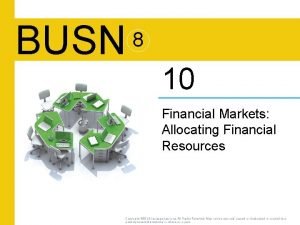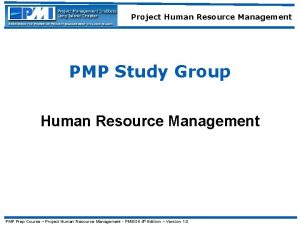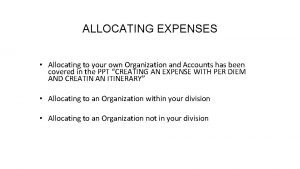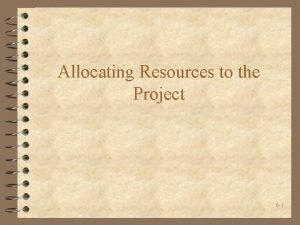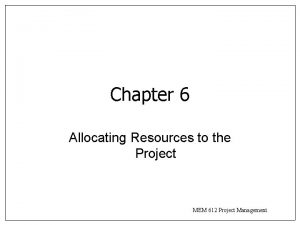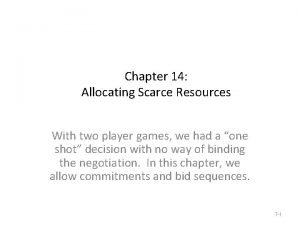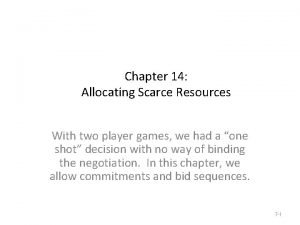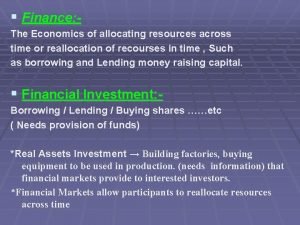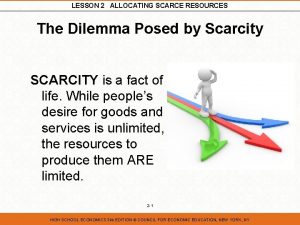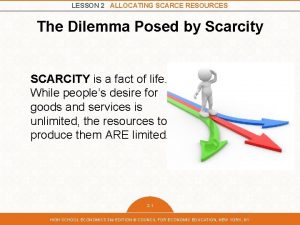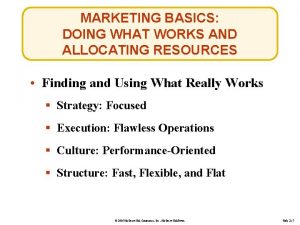Allocating Resources to the Project 6 1 Introduction




















































- Slides: 52

Allocating Resources to the Project 6 -1

Introduction 4 Projects Compete With One Another for Resources – resources that are not consumed – resources that are consumed 4 Goal of Resource Allocation is to Optimize Use of Limited Supply 4 Requires making trade-offs – time constrained – resource constrained 2

EXPEDITING A PROJECT 6 -3

The Critical Path Method 4 Normal Duration Estimates 4 Normal Costs 4 Crash Duration Estimates 4 Crash Cost Per Day 4

Normal Crash Cost per Activity Predecessor Duration Cost Day a ----- 6 days 5 days $60 $90 $30/d b ----- 7 4 50 150 33/d c a 6 4* 100 160 N. A. d a 7 7 30 30 N. A. e b 5 4 70 85 15/d f c 9 7 40 120 40/d g d, e 7 4 50 230 60/d 5

Figure 6 -1(a) Gantt Chart Crash Problem -- 21 -Day Project 6

Figure 6 -1(b) AON Network for Sample Crash Problem -- 21 -Day Project 7

Figure 6 -2 Gantt Chart for 20 Day Solution to Crash Problem 8

Figure 6 -3 Gantt Chart for 19 Day Solution to Crash Problem 9

Figure 6 -4 Gantt Chart for 18 Day Solution to Crash Problem 10

Figure 6 -5 Gantt Chart for 16 Day Solution to Crash Problem 11

Figure 6 -6 Project Cost Versus Project Duration for Sample Crash Problem 12

Using Excel’s Solver to Crash a Project 4 Target Cell – minimize crashing costs 4 By Changing Cells – amount to crash activities – time events occur 4 Constraints – amount each activity can be crashed – precedence relationships – complete project by specified time – nonnegativity 13

Fast-Tracking a Project 4 Used Primarily in Construction Industry 4 Building phase started before design and planning phases completed 4 Particularly appropriate when large proportion of work is routine 14

RESOURCE LOADING 6 -15

Resource Loading 4 Amount of specific resources that are scheduled for use on specific activities or projects at specific times. 4 Usually a list or table. 16

Figure 6 -10 Action Plan and Gantt Chart for Production of a Videotape 17

The Charismatic VP 4 Subordinates have hard time saying no to well liked boss. 4 Leads to overcommitted subordinates. 4 Problem further compounded because more experienced workers tend to be most over worked. 4 One solution is to set specific limits on amount of overscheduling permitted. 18

RESOURCE LEVELING 6 -19

Figure 6 -10 Action Plan and Gantt Chart for Production of a Videotape 20

Figure 6 -12 Resource Overallocation Report for Scriptwriter Showing all Activities 21

Figure 6 -13 Graphic Resource Overallocation Report for Scriptwriter 22

Figure 6 -14 Resource Leveled Report for Scriptwriter Showing all Activities 23

Figure 6 -15 Graphic Resource Leveled Report for Scriptwriter 24

Figure 6 -16 Daily Resource Loading Chart for Videotape Project, Scriptwriter Leveled 25

Figure 6 -17 Final Videotape Project Gantt Chart Schedule, With Two Scriptwriters and Producer Leveled 26

Figure 6 -18 Thirty-Four-Week Resource Loading Chart for a Software Engineering Group 27

Resource Loading/Leveling and Uncertainty 4 28, 282 Hours Needed 4 Group Capacity – 21 (people) 40 (hrs/wk) 34 wk = 28, 560 labor hrs 4 Correction for Holidays – 21 3 (days) 8 (hours) = 504 labor hrs 4 Vacations – 11 2 (weeks) 40 = 880 labor hrs 28

Resource Loading/Leveling and Uncertainty continued 4 Hours Available – 28, 560 - 504 - 880 = 27, 176 – about 1100 less than needed – 28, 282/27176 = 1. 04 4 What about – Workers getting sick? – Task not ready when worker is ready? – Change orders? 29

ALLOCATING SCARCE RESOURCES TO PROJECTS 6 -30

Use of Software 4 Begin with Pert/CPM Schedule 4 Activities examined period by period and resource by resource 4 In cases where demand for resource exceeds supply, tasks considered one by one and resources assigned to these tasks based on priority rules 31

Some Comments about Constrained Resources 4 Scarcity of resources rarely applies to resources in general 4 “Walts” 32

Some Priority Rules 4 As soon as possible 4 As late as possible 4 Shortest task duration first 4 Minimum slack first 4 Most critical followers 4 Most successor 4 Most resources first 33

Choosing a Priority Rule 4 Schedule Slippage – amount project or set of projects delayed 4 Resource Utilization – extent that resources are over or underworked 4 In-Process Inventory – amount of unfinished work in the system 34

ALLOCATING SCARCE RESOURCES TO SEVERAL PROJECTS 6 -35

Pseudoactivities 4 Used to link several project together 4 Have duration but do not require any resources 4 This approach allows a set of projects to be dealt with as though it were a single project – use of MSP’s resource loading and leveling charts and tables 36

Figure 6 -19 Multiple Projects Connected with Pseudoactivities Shown on a Time Line 37

Resource Allocation and the Project Life Cycle Figure 6 -20 Project or task life cycles 38

GOLDRATT’S CRITICAL CHAIN 6 -39

Introduction 4 Similar issues that trouble people about working on projects regardless of type of project – – unrealistic due dates too many changes resources and data not available unrealistic budget 4 These issues/problems related to need to make trade-offs 4 To what extent are these problems caused by human decisions and practices? 40

Figure 6 -21 Three Project Scenarios 41

Table 6 -6 Project Completion Time Statistics Based on Simulating Three Projects 200 Times 42

Observations on Estimating Task Times 4 Average Completion Times 4 Optimistic Completion Times 4 Pessimistic Completion Times 4 Implications of Assuming Known Activity Times 4 Impact of Inflated Time Estimates 4 Shape of the Distribution 4 Worker Time Estimates 4 Student Syndrome 43

Multitasking Figure 6 -24 Two Small Projects 44

Figure 6 -25 Alternative Gantt Charts for Projects A and B 45

Common Chain of Events 4 Underestimate time needed to complete project – assumption of known activity times and independent paths 4 Project team members inflate time estimates 4 Work fills available time – student syndrome – early completions not reported 46

Common Chain of Events continued 4 Safety time misused 4 Misused safety time results in missed deadlines 4 Hidden safety time complicates task of prioritizing project activities 4 Lack of clear priorities results in poor multitasking 47

Common Chain of Events concluded 4 Poor multitasking increases task durations 4 Uneven demand on resources also results due to poor multitasking 4 More projects undertaken to ensure all resources fully utilized 4 More projects further increases poor multitasking 48

Reversing the Cycle 4 Reduce number of projects assigned to each individual 4 Schedule start of new projects based on availability of bottleneck resources 4 Reduce amount of safety time added to individual tasks and then add some fraction back as project buffer – activity durations set so that there is a high probability the task will not be finished on time 49

The Critical Chain 4 Longest chain of consecutively dependent events – considers both precedence relationships and resource dependencies 4 Project Buffer 4 Feeding Buffer 50

Figure 6 -26 Sample Network Diagram 51

Figure 6 -27 Project and Feeder Buffers 52
 Markets allocating resources
Markets allocating resources Allocating kernel memory in os
Allocating kernel memory in os Lower level file system algorithms
Lower level file system algorithms Transformation process
Transformation process Fixed resources and variable resources
Fixed resources and variable resources Renewable vs nonrenewable resources worksheet
Renewable vs nonrenewable resources worksheet Hình ảnh bộ gõ cơ thể búng tay
Hình ảnh bộ gõ cơ thể búng tay Lp html
Lp html Bổ thể
Bổ thể Tỉ lệ cơ thể trẻ em
Tỉ lệ cơ thể trẻ em Chó sói
Chó sói Thang điểm glasgow
Thang điểm glasgow Alleluia hat len nguoi oi
Alleluia hat len nguoi oi Môn thể thao bắt đầu bằng từ đua
Môn thể thao bắt đầu bằng từ đua Thế nào là hệ số cao nhất
Thế nào là hệ số cao nhất Các châu lục và đại dương trên thế giới
Các châu lục và đại dương trên thế giới Công thức tiính động năng
Công thức tiính động năng Trời xanh đây là của chúng ta thể thơ
Trời xanh đây là của chúng ta thể thơ Mật thư tọa độ 5x5
Mật thư tọa độ 5x5 Làm thế nào để 102-1=99
Làm thế nào để 102-1=99 Phản ứng thế ankan
Phản ứng thế ankan Các châu lục và đại dương trên thế giới
Các châu lục và đại dương trên thế giới Thơ thất ngôn tứ tuyệt đường luật
Thơ thất ngôn tứ tuyệt đường luật Quá trình desamine hóa có thể tạo ra
Quá trình desamine hóa có thể tạo ra Một số thể thơ truyền thống
Một số thể thơ truyền thống Cái miệng nó xinh thế
Cái miệng nó xinh thế Vẽ hình chiếu vuông góc của vật thể sau
Vẽ hình chiếu vuông góc của vật thể sau Nguyên nhân của sự mỏi cơ sinh 8
Nguyên nhân của sự mỏi cơ sinh 8 đặc điểm cơ thể của người tối cổ
đặc điểm cơ thể của người tối cổ Thế nào là giọng cùng tên?
Thế nào là giọng cùng tên? Vẽ hình chiếu đứng bằng cạnh của vật thể
Vẽ hình chiếu đứng bằng cạnh của vật thể Vẽ hình chiếu vuông góc của vật thể sau
Vẽ hình chiếu vuông góc của vật thể sau Thẻ vin
Thẻ vin đại từ thay thế
đại từ thay thế điện thế nghỉ
điện thế nghỉ Tư thế ngồi viết
Tư thế ngồi viết Diễn thế sinh thái là
Diễn thế sinh thái là Các loại đột biến cấu trúc nhiễm sắc thể
Các loại đột biến cấu trúc nhiễm sắc thể Bảng số nguyên tố
Bảng số nguyên tố Tư thế ngồi viết
Tư thế ngồi viết Lời thề hippocrates
Lời thề hippocrates Thiếu nhi thế giới liên hoan
Thiếu nhi thế giới liên hoan ưu thế lai là gì
ưu thế lai là gì Hươu thường đẻ mỗi lứa mấy con
Hươu thường đẻ mỗi lứa mấy con Sự nuôi và dạy con của hổ
Sự nuôi và dạy con của hổ Sơ đồ cơ thể người
Sơ đồ cơ thể người Từ ngữ thể hiện lòng nhân hậu
Từ ngữ thể hiện lòng nhân hậu Thế nào là mạng điện lắp đặt kiểu nổi
Thế nào là mạng điện lắp đặt kiểu nổi Resource histogram vs responsibility assignment matrix
Resource histogram vs responsibility assignment matrix Pmp roles and responsibilities
Pmp roles and responsibilities Human resource management lecture chapter 1
Human resource management lecture chapter 1 Introduction about energy resources
Introduction about energy resources The role of project management in achieving project success
The role of project management in achieving project success
